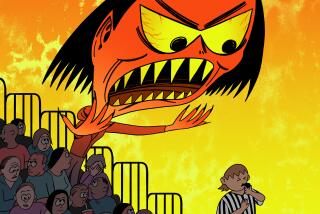Never Too Early to Put Kids on Path to Fitness
- Share via
It seems just the day for a trip to the neighborhood park: The sun is shining, the sky is blue and a gentle breeze is blowing. But your child shows scant interest in climbing the jungle gym or kicking a ball. Her eyes are glued to the TV, following every antic of Garfield the cat.
Television, Nintendo, the neighborhood video store--the list of enticements to keep kids on the couch seems to grow every day. Add to this the hectic schedules of parents trying to squeeze 48 hours of work into 24 hours, and the kids’ physical fitness often comes in last.
“Children have a lot of sedentary time from a young age,” said Joan Morgan, who oversees the physical and occupational therapy program at the Children’s Hospital’s Rancho Bernardo and South Bay centers. “They could be in school for five hours a day.” But most of that time is spent sitting at their desks, she said, and most children don’t have daily physical education classes.
Health experts seem to agree that it is never too early to start kids on the fitness track, and a fit child will also find it easier to become an active adult.
“From Day 1, parents need to be aware of motor development and give their children opportunities to develop their motor skills and not just assume that it happens,” Morgan said.
In addition to the health benefits, a physically fit child is likely to have more confidence in tackling other challenges, Morgan said.
“If you have a child who can ride her bike, play with her friends and play on the soccer team, she is going to have more confidence to take on the challenges in the classroom,” she said.
Children who have a well-honed body awareness, and good right and left discrimination, also tend to translate symbols more easily. They are also more adept at pencil-to-paper tasks, Morgan said.
“If you have very weak shoulders because you have not used your body a lot in climbing or crawling, your hand is going to fatigue greatly,” she said.
How to tell when your child is not in the best shape?
According to Morgan, a child’s weight is a good indicator of fitness. Also, lethargy and a preference for sedentary activities, like watching too much television and sleeping a lot, signal a lack of fitness. However, cautions Morgan, even a lean and energetic child might have some problem areas.
“A 7- or 8-year-old who really struggles to get his shoes or socks on because he can’t reach them probably has very tight muscles and should go on a mild exercise program to stretch his muscles out,” she said.
Make fitness a family affair, Morgan counsels. Being active can become second nature when it is incorporated into daily family routines. Go hiking, swimming, walking or just do sit ups in the family room--but do them with your kids.
“It might seem easier to send the children to watch television and grab a few quiet moments for yourself after dinner,” Morgan said. “But try to leave the dinner dishes and go for a walk around the block with your kids.”
One of the best ways to help children become active is to expose them to a variety of programs, then let them choose what they enjoy most, even if it means an extra 30 minutes of driving. “A child who does not like running or who does not like group sports may do well in tennis or judo,” Morgan said. “It is very easy to plug your child into things that are right there in the neighborhood.”
Key considerations in evaluating a program should be safe equipment, safe programming and good supervision. As the child matures, especially in gymnastics programs, parents also need to pay attention to the amount of time spent in stretching, on flexibility and spotting or guarding.
“Even at age 4 or 5, youngsters can get into trouble in gymnastic routines if they are not carefully monitored,” Morgan said.
Two of the most common sports injuries in children are muscle overuse and injuries to the growth plate, said Lisa Miller, a pediatric orthopedic surgeon who practices in Escondido and at Children’s Hospital.
Overuse injuries occur when children perform activities for which they don’t have the needed strength or flexibility. Typically, Miller said, treatment for this type of injury includes restricting or decreasing the activity level, depending on the severity of the injury.
Injuries to the growth plate occur only in children, Miller said. Children’s bones grow from either end, she explains, and on each end of the longer bones is a cartilage area called the growth plate, which is susceptible to injuries, such as a fall while roller skating. Such injuries are often misdiagnosed as sprains, said Miller, but without proper diagnosis and treatment, the injury could inhibit proper development of the bone, resulting in short or crooked growth.
What precautions will help to minimize sports injuries in children?
According to Miller, the key to preventing injuries is proper conditioning, which includes strength and flexibility training. Good coaching is also important to modify a child’s technique, she said.
“They may not be pitching right or serving right,” she said. “When they have poor technique, that is often a key factor in leading to injuries.”


